Thu 15 Mar 2012
ADVENTURES IN COLLECTING: My Favorite Magazines, by Walker Martin.
Posted by Steve under Collecting , Columns , Pulp Fiction[34] Comments
My Favorite Magazines
by Walker Martin
I collect and read quite a few other types of magazines besides the pulps. A couple of members of FictionMags, an online Yahoo discussion group, asked me about my favorite magazines, so I thought I’d take this opportunity to discuss the subject.
Slicks —
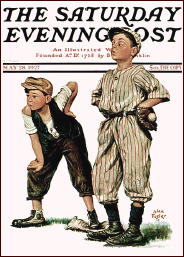
This is easy for me to answer. My favorite slick magazine without a doubt is The Saturday Evening Post. They used the best authors and the best artists. It was weekly and some issues in the 1920’s were 200 pages.
Usually collectors of the Post concentrate on certain authors or artists. Since thousands of issues were published you do not find many people trying to collect the entire run. However, I was one of the completists and at one point I had over 3,000 issues during the 1900-1970 period.
The last time I moved not only could I not pick up the yearly boxes of the magazine (each box had 52 issues), but the movers had trouble also because of the weight. Eventually I sold much of the collection but I still have a complete run of 1940-1970.
Another slick I liked a lot was American Magazine, mainly because of the mystery short novels they published. Jon Breen edited a collection of these novellas called American Murders.
Digests —
This is a far more difficult category for me to choose a favorite but I’ll go with Galaxy for the SF genre and Manhunt for the crime genre.
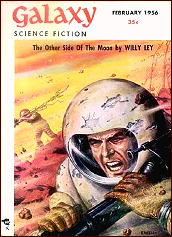
Galaxy was the first magazine I bought off the newsstand in 1956 and it led to my present collection of many different titles. But my reason for picking Galaxy is not just nostalgic. I really feel that it was the best of the SF digests especially under the editorship of H.L. Gold and Fred Pohl.
Pohl was smart enough to offer Robert Silverberg a deal to buy all of his stories submitted to Galaxy in the 1965-1972 period or thereabouts. Some of the best SF ever written appeared during this period and I’ve read many of Silverberg’s stories and serials more than once.
Has there ever been a greater or higher quality number of novels in any SF magazine? I mean, think of it: The World Inside, Tower of Glass, Downward to Earth, Dying Inside, all in about two years.
Alfred Bester wrote two great novels but they were in 1952 and 1956. J.G. Ballard wrote some great novels but they all did not appear in the SF magazines. Maybe Philip K. Dick comes closest but again, he did not write all of them for the SF magazines. Sturgeon had some great work in Galaxy but it was all novelette length.
Can anyone show me a comparable run of novels in the SF magazines?
Manhunt lasted 114 issues during 1953-1967 and during the fifties started the hardboiled crime digest craze. At one time there seemed to be dozens of Manhunt imitators but none of them could match the quality of the magazine that started it all.
Unfortunately by the sixties it was all downhill and the hardboiled crime era was just about over. Two crime digest still exist, though they are not really hardboiled like Manhunt: Ellery Queen Mystery Magazine and Alfred Hitchcock Mystery Magazine.
Circulations are dropping fast and in these days of the e-book revolution, we will probably see the end of the digest magazines.
Literary Magazines —

By literary I mean such magazines as the Hudson Review, T. S. Eliot’s Criterion, Scrutiny, Kenyon Review, and so on.
I have just about all the back issues of many of the quarterlies and I love the Hudson Review, but my favorite is Horizon, not the hardbound art magazine but the monthly British magazine edited by Cyril Connolly during 1940-1949. It lasted 120 issues and I like it so much that I have two sets, one of loose issues and one bound set.
There are other magazines that I have in two sets, loose and bound and you know you have to love a magazine to have it in bound and loose sets! Let’s face it, collecting books and magazines can be an addiction like alcohol, smoking, gambling, and drugs. But at least we get something to read and sometimes the books are even worth money. Not to mention that collecting old magazines won’t harm your health.
Men’s Adventure Magazines —
This is a sore point with me and maybe some of you can help me out. I have hundreds of issues from the 1950’s and 1960’s, most showing sensationalistic covers like Nazis partying with half nude girls, while GI’s wait to gun them down. I have yet to find a title that ran decent fiction other than maybe Cavalier in the fifties.

I’m not talking about Playboy which actually ran high quality fiction, but the titles like Men’s Adventure, True Men and so on. The only redeeming value to these magazines are the crazy covers but I’m hoping someone here can convince me otherwise.
Phil Stephensen-Payne has a great link to many titles of men’s adventure magazines published in the 1950’s and 1960’s http://www.philsp.com/mfi2.html
Please someone show me something else about these magazine that is readable! I’ve just about given up. The covers are stunning and very eye catching but that’s all I see about these magazines. I guess the WW II vets loved these things but I can’t see anything other than the covers worth collecting.
Check out the link to menspulpmags.com. It’s a real laugh.
At one time I had a great cover painting from one of the men’s adventure magazines. It show Nazis turning girls into gold ingots. No wonder they lost the war.
PULP MAGAZINES:
I haven’t even touched the pulps which are such a big subject they deserve their own section separated by genre:
General Fiction Pulps —
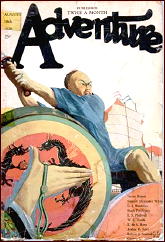
These pulps are often called adventure pulps by collectors but I prefer the label General Fiction. The best ones lasted for very long periods and were very popular with male readers. All Story, Argosy, Short Stories, Blue Book, Adventure, and Popular Magazine were the main titles and I’ve collected them all:
Adventure Magazine is my favorite and the pulp years lasted from 1910-1953, for 753 issues. The best period was during the 1920’s when editor Arthur Sullivant Hoffman managed to obtain the very best action and adventure fiction. Richard Bleiler wrote the standard history of the magazine in his Adventure Index. Also Blood n Thunder Magazine devoted a special issue to Adventure a couple issues ago. I had an article picking my favorite stories.
All Story lasted for over 400 issues, 1905-1920, when it was absorbed by Argosy. Famous for providing Edgar Rice Burroughs with a market for his Tarzan and Mars novels. Sam Moskowitz wrote an interesting history of the magazine in Under the Moons of Mars.
Argosy became the first pulp in 1896 and lasted into the 1940’s when it became a man’s adventure magazine.
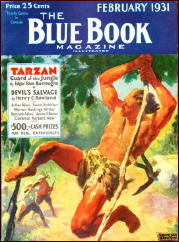
Short Stories began in 1890 and lasted into the 1960’s. For much of that period it came out every two weeks like clockwork and printed the best action adventure. Blood n Thunder had a long two part article covering the 1920’s and 1930’s.
Blue Book was known for quality fiction and Mike Ashley wrote a long history of the magazine which appears in Pulp Vault 14. This is the best single issue of a pulp fanzine and can be ordered on Amazon.
Popular Magazine lasted over 600 issues, 1903-1931 and was called the training ground for the Saturday Evening Post. Another high quality pulp that had a two part article in Blood n Thunder.
Detective and Mystery Pulps —
This is easy because of what collectors call “The Big Three”: Black Mask, Dime Detective, and Detective Fiction Weekly. Hammett started in Black Mask and Chandler wrote for all three.
Western Pulps —
Western Story lasted over 1200 issues and is my favorite. But West during the Doubleday years of 1926-1935 was also quite good. So was Star Western and Dime Western, both published by Popular Publications.
Hero Pulps —
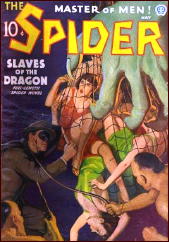
Most were aimed at the teenage boy market but at least two stand out: The Spider because of the crazy, fast moving plots and weird menace elements and Secret Agent X because it was not as childish as the others.
I have to admit that I have a problem with many of the hero pulps because of the silly and sometimes stupid sidekicks. I know they were in there because someone figured the teenage boys would like them. Sort of like the childish sidekick humor in the B-westerns of the 1940’s.
Some of the pulp sidekicks make the western sidekicks look brilliant. In Doc Savage we have Monk and Ham, for instance and their dialog and attempts at humor are enough to make me stop reading. Same thing with G-8 and His Battle Aces. Nippy and Bull have made me consider ripping up a $100 G-8 pulp.
SF and Supernatural Pulps —
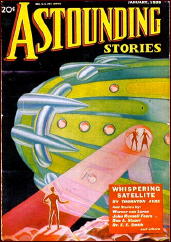
Astounding definitely was the best SF pulp. Weird Tales and Unknown Worlds, the best supernatural. Strange Tales, if it had lasted longer than seven issues, it would have been as good or better than the other two.
Famous Fantastic Mysteries and the companion magazine, Fantastic Novels, are beautiful pulps. It is still possible to get a set without breaking the bank, and these magazines are another example of sets that I have in two formats: bound and unbound. I admit it’s crazy to have two sets, but who said love is logical?
Sport Pulps —
Street and Smith’s Sport Story was by far the best sport pulp.
Love Pulps —
These were the best sellers of the pulps because teenage girls and young women bought them. Love Story was the best with a circulation that reached 500,000 a week. Edited by the great Daisy Bacon.
I’d appreciate any feedback on the above that you would care to provide. Do you disagree or have other favorites?
ADDED LATER:
Todd Mason mentioned that the Daisy Bacon years where she edited Detective Story are underrated. This is certainly true especially the digest period in the 1940’s.
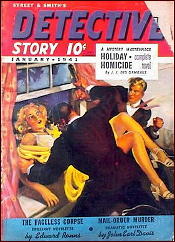
In 1943 Street & Smith changed the format of their entire pulp line of magazines from the standard pulp size of 7×10 inches to the smaller digest size. The paper shortages during WW II probably drove this decision. Then the publishers saw that the future looked bleak for pulps and killed every digest title except for Astounding.
But to get back to Daisy Bacon, she was the guiding force behind Love Story for two decades and then she took over Detective Story and actually introduced a more hardboiled story to the sedate magazine.
Detective Story had started in 1915 and for most of the next 25 years steered clear of the hardboiled type of story. But Daisy managed to get some of the Black Mask writers to write for her, for instance Roger Torrey and William Campbell Gault. Fred Brown also. I cover the history and many of the authors of Detective Story in an article which can be seen here on the Mystery*File blog.
When I say Love Story was the best of the love pulps, I’m speaking compared to each other. Since I try to collect every fiction magazine under the sun, I made an attempt, more than once, to read Love Story and some of the competition.
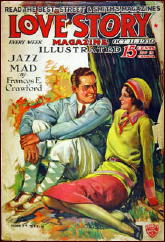
I would not advise anyone to try this experiment. Despite being the best sellers among all the pulps, the love genre was very restrictive to say the least. The young ladies and teenage girls of the 20’s, 30’s, and 40’s, only wanted to read the same formula over and over, and the love pulps gave it to them, over and over.
I’m speaking of the girl meets boy, they have some problems, and everything is resolved at the end. Ranch Romances was different from the others, but I see it as mainly a western title with some romance elements.
The love genre may have been the big sellers among pulps (and even slicks since the readership was mostly women), but nowadays collectors mainly ignore them and copies can be had very cheaply. I can count very few people who collect them.
When I bid on some copies at a recent pulp convention, several of my collector friends burst out laughing or were just stunned speechless. I could only explain my seemingly insane actions as an attempt to collect something new, since I’ve collected everything else.
Previously in this series: The FRANK M. ROBINSON Collection Auction.
March 15th, 2012 at 7:07 pm
Phew, Walker, there is a lot of paper around !
With the exception of the hard-boiled mags, all the publications mentioned above were new to me.
The Mens’ Adventure stuff is out of this world, to put it mildly !
The Doc
March 15th, 2012 at 7:32 pm
What is the male vs female ratio for pulp collectors?
March 15th, 2012 at 8:31 pm
michael, collecting being a man’s world, I’d guess 1 : 10 .
The Doc
March 15th, 2012 at 8:58 pm
I really ought to wait for Walker to answer this, but while there are women who come to pulp shows, most of them are with husbands or boy friends. For pulp or magazine collectors, I’d say the ratio is closer to 100 to 1. Women can have large collections of things, but not pulps.
March 15th, 2012 at 9:14 pm
I asked that because it would explain why there is little interest in the Romance pulps.
Of course, whenever one from the female side accuses me of never growing up, I think of experiences such as pulps reading and feel sorry for the women that they had to grow up.
March 15th, 2012 at 10:30 pm
The Doc mentions the men’s adventure magazines being out of this world. They are indeed very bizarre and the covers are often very objectionable showing women and men being tortured by insane cretins. But that seems to be their main attraction, in fact their only attraction to the collectors that specialize in these magazines.
There are several books that readers can refer to if they wish to learn more about the politically incorrect world of the men’s adventure magazines:
MEN’S ADVENTURE MAGAZINES. This is the enormous Taschen book based on the Rich Oberg collection of original art. Over 500 pages showing cover images that reportedly have driven some readers insane. Rich Oberg lists me as one of the people that started him down this road of ruin.
IT’S A MAN’S WORLD by Adam Parfrey. Another big book discussing and showing images of the “Postwar Pulps”.
ALL MAN by David M. Earle. Written by a university professor, this book discusses Ernest Hemingway and 1950’s Men’s Magazines.
LUCKY BRUCE: A LITERARY MEMOIR by Bruce Jay Friedman. Somehow the author survived the ordeal of editing some of the men’s adventure magazines.
HorrorHound, July/August 2011, issue number 30. Big 6 page article, showing 65 cover images from the Rich Oberg Collection.
March 15th, 2012 at 10:46 pm
As Steve mentions, there are very few women magazine collectors. I’ve been attending pulp conventions since 1972 and have only run across a very few women collectors. I do recall Pat Erhart, who collected Cornell Woolrich; a female librarian at Bowling Green University, who collected love pulps; and several ladies collecting magazines that their grandfathers or relatives wrote for. Examples being Karen Cunningham, who’s grandfather was pulp author Fred Davis; Laurie Powers, who’s grandfather was Paul Powers; and Nicky Brown who is related to Malcolm Wheeler-Nicholson.
These last three ladies were at last year’s PulpFest on a panel discussing pulps. Laurie Powers is just about the only female who actually branched out beyond her grandfather. She has a blog discussing pulps called LAURIES WILD WEST and is presently doing research on Daisy Bacon, the editor of LOVE STORY and DETECTIVE STORY.
Another woman pulp collector is Michelle Nolan, who regularly attends Windy City and PulpFest. She specializes in sport and love pulps, among others. She has an upcoming book on the sport pulps which will be a major publishing event since very little has been written about this genre.
March 16th, 2012 at 7:48 am
Loved the article! I admire your wide-ranging collection and envy your thousands of issues of Saturday Evening Post. I have some scattered issues picked up through the years with favorite authors but no real collection. Not sure how widespread the practice is but many of the old slicks are being cut up for their ads which are sold separately.
One category that I do collect that you did not mention are the outdoors magazines such as Field and Stream, Outdoor Life, Sports Afield. Some pulp writers also wrote for these including James B. Hendryx and W.C. Tuttle.
There were at least two types of “men’s magazines” with one type going for the Nazi love slaves nonsense. The other is exemplified by Argosy where it continued carrying some fiction but began to include outdoors and travel articles, sports personality pieces, and (one of my favorites) Erle Stanley Gardner’s “Court of Last Resort” series.
I began to accumulate the slick issues of Argosy for the Gardner articles and fiction by Merle Constiner, Robert Edmund Alter, and others.
Great piece. Thanks Walker
March 16th, 2012 at 8:26 am
Of course, ARGOSY (US edition) of that vintage always struck me as the down-market version of ESQUIRE…a bit less polished, a bit more machismic…Paul Bishop highlights today MAN’S WORLD, which almost admits on its covers the fictional nature of its contents, not quite name-checking the apparent fact they were running Alistair MacLean novels (excerpts?) in their issues. I now Need to get that Friedman book, having been a long-term fan of BJF.
It would be something to find a romance pulp (beyond RANCH ROMANCES and its imitators) that consistently or even frequently ran good fiction (even some of the latter-day digests, such as FIVE GREAT ROMANCES, ran some fiction that wouldn’t’ve been out of place in AHMM except the stories had more sex in them), but if any pulp title had the potential to do so, I suspect it was Daisy Bacon’s LOVE STORY…or so I’d suspect due to the quality of her DETECTIVE STORY for Street and Smith, which as I’ve noted elsewhere was almost foolishly representative of the full range of pulp crime fiction, from the coziest through hardboiled to shudder pulp…but even in the last category presented some of the best she could find of each type.
March 16th, 2012 at 8:28 am
That Nolan book sounds necessary as well. Yours for William Campbell Gault sports fiction…
March 16th, 2012 at 8:58 am
Richard Moore in Comment #8 brings up a couple interesting subjects, such as the fact that it is getting harder and harder to find slick magazines that have not been cut up by Breakers. These sellers, who you can see at Flea markets, routinely excerpt and cut out advertisements from the slick magazines. They then sell the ads to housewives and husbands, who often frame them and hang them up in kitchens, finished basements, mancaves, etc.
Breakers get their name because they actually “break” and ruin magazines. It is getting so difficult to find slicks where the breakers have not been exercising their terrible craft, that I would recommend that you count each page in a slick before buying it. I once was stuck with $3,500 worth of slicks that had been ruined by this practice. Breakers will even ruin an expensive magazine in nice condition because it is worth more cut up than whole.
On a more cheerful subject, Richard mentions ARGOSY, which became a quality man’s adventure magazine in the 1940’s. I have many issues also and agree that it was not at all like the usual men’s adventure magazine.
March 16th, 2012 at 9:08 am
In Comment #9 Todd mentions one of my favorite blogs, BISH’S BEAT. Paul Bishop evidently is addicted to the covers of the men’s adventure magazines, like so many of us. He often posts a cover which needs no comment at all because they are so insanely over the top and bizarre. If you go to his website and click on the label “mens adventure”, you will be deluged with images that will forever affect your sanity. Don’t let your wife or girlfriend see you looking at these covers. For some reason many women take offense when they see women in peril covers of the men’s adventure magazines.
March 16th, 2012 at 9:22 am
Walker, please don’t ever run out of fascinating comments about magazines, pulps and otherwise!
I, too, grew up with The Saturday Evening Post (my grandparents had a subscription for more than 60 years!). Although I pick up the occasional slick magazine that interests me — I have several hundred of all types — I couldn’t begin to collect sets of magazines like you have, since I also collect so many pulps, books and comics (almost 34,000 items on my shelves). So I would agree with you that The Post is tops among the slicks. I have books with the cover images, including some great non-Rockwells as well as the Rockwells.
The “sweat magazines” (other than some quality from the likes of post-pulp Argosy) don’t interest me — I think the covers are generally outrageous and often poorly drawn and the writing is usally poor — but I agree with almost all of your favorite picks in pulps.
The only area where I can’t agree is saying Sport Story Magazine from S&S was the best sports pulp. Actually, many of the S&S stories are pretty hard to read compared with stories in the Thrilling and Popular sports pulps, although the non-fiction in Sport Story Magazine is usually far superior to the other sports publishers. For some reason, Street & Smith was able to get some of the top non-fiction sports writers to produce for them, probably because S&S also produced the best all-non-fiction baseball and football yearbook type magazines, etc.
Both Thrilling and Popular often produced better sports fiction than they did tales in other genres, especially in coming up with twists on standard sports plots. There really are some very entertaining baseball and football stories from these two companies. However, the sports pulps from Ace, Columbia, Red Circle and Fiction House (aside from some incredible cover artists!) had wildly erratic quality.
I collect romance pulps primarily for their covers, but I’m nowhere near a completist (there were more than 7,000 love pulps, not even including western romance!). I’m a completist only on the Thrilling group (where I collect the entire company). As you say, Love Story Magazine probably was the best from the standpoint of story quality, but Popular came up with a handful of authors who would often tell a good romance story. Thrilling also had the occasional good romance novelette. I have a sixth sense when I read the TOC about whether there’s a good story. I love many of the stories in Ranch Romances — that really was a good pulp! A lot of people laugh at me when they see me buying Ranch Romances, but I do enjoy them. Thrilling Ranch Stories and Rodeo Romances aren’t too bad, either.
The love pulps had nowhere near the variety of plot twists that the sports pulps had.
I also love detective, hero and western pulps. War stories don’t appeal to me, nor do the horror and exploitation pulps, but then I can’t afford those anyway.
March 16th, 2012 at 9:46 am
Ah. Well, the editor at Columbia, at least (and possibly the one at Ace) had little enthusiasm for sports fiction, though Robert Lowndes did edit the last of the sports pulps (and such not quite improbable contributors as Robert Silverberg and fan and book-dealer Robert Madle published fiction in it). I’d suspected that S&S might have some sort of edge in their sports pulps due to their nonfiction-title interest…and wondered how many other folks beyond WC Gault were publishing first-rate sports fiction in the pulps on a regular basis (Damon Knight’s memoirs of editing at Popular note WCG was publishing a lot with them, and I wonder how many shorts he placed with S&S and others over the decade or so he was most productive with short sports fiction).
March 16th, 2012 at 9:51 am
For the eclectic littles, I’ll note such favorites as ONTARIO REVIEW, EPOCH, THE PARIS REVIEW, BOULEVARD, BLACK CLOCK, TRIQUARTERLY in the years Robert Onopa was one of the editors, and ANTAEUS…all of which have published considerable fiction of relevance here.
March 16th, 2012 at 9:57 am
And distinctions should be drawn between the pulp magazines which featured a lot of actually good horror fiction (such as WEIRD TALES, STRANGE TALES, FAMOUS FANTASTIC MYSTERIES, FANTASTIC ADVENTURES particularly in some of Howard Browne’s late issues, and the undersung and shortlived STRANGE STORIES) and those which featured essentially only shudder/torture fiction (such as HORROR STORIES, TERROR TALES, DIME MYSTERY early on, one or two of the UNCANNY TALES titles, and such latter-day magazines as WEB TERROR TALES, all of which were inspirations for the nastier of men’s sweat magazines). Even when writers as good as Hugh B. Cave and Henry Kuttner could write for both (but I wouldn’t recommend the shudder of either fellow except as Good Of Kind, versus their brilliant best work for other markets).
March 16th, 2012 at 9:59 am
Hmm…among the good horror magazines, did I leave an obvious example out? Oh, yes…UNKNOWN/UNKNOWN WORLDS. At least Walker wasn’t so forgetful above.
March 16th, 2012 at 10:05 am
I grabbed a few issues off my shelves of the slick Argosy and was interested in the changing description under the cover logo.
In October 1948, under Argosy, was “For Men”
In July 1950, “The Complete Men’s Magazine” and this lasted for several years through 1956.
In 1957, it becomes “The Largest Selling Fiction-Fact Magazine for Men.” This one lasted on the cover at least into 1959.
In February 1962, the “Largest Selling…” goes inside on the contents page. On the cover, the old “For Men” returns under the logo.
By 1965, “The No. 1 Men’s Service Magazine. The contents now include articles such as “SPACE VISITORS, They’ve Already Been Here” and “Billions in Gold, Touch It If You Dare.” Still includes fiction such as September 1965, stories by Robert Edmond Alter, Arthur Porges and Robert L. Fish.
My issues are more scattered in the later years but by 1972, the emphasis in contents was on travel. June 1972 has “See America First” to the right of the logo. October 1972 has the “See America First” next to the logo in a field of red and including stars next to “See.” Under the logo is “1st in Travel, Recreation and Outdoor Living.”
My impression is that the magazine found a niche that carried it through the 1950s but began lurching in various directions in the 1960s trying to find a successful formula.
March 16th, 2012 at 10:34 am
Michelle in Comment #13 is probably right about the best sport pulps. I consider her the expert on the genre, at least in the pulp magazines. She has written a book about sports fiction called BALL TALES but her upcoming book will have alot more detail and information about the actual pulps. I believe I reviewed BALL TALES for Mystery File a couple years ago.
March 16th, 2012 at 10:40 am
Todd in Comment #15 mentions some of my favorite literary magazines. For some reason other magazine collectors avoid the room where I have most of my literary titles shelved. I think most of them like the pulpier magazines. The pulps certainly had more interesting covers!
March 16th, 2012 at 1:13 pm
Here are links to some of the blogs and other sites mentioned in the comments so far:
Laurie Powers’ blog: http://lauriepowerswildwest.blogspot.com/
Paul Bishop’s blog: http://bishsbeat.blogspot.com/
Walker Martin’s review of BALL TALES, by Michelle Nolan: https://mysteryfile.com/blog/?p=3548
March 16th, 2012 at 1:59 pm
Your usual great job, Walker! Murania Press should be vying for the rights to publish “The Ramblings and Rumblings of a Pulp Steward…or How I gave Up Trying to Be Husband Of The Year And Concentrated On Popular Fiction” 🙂
March 16th, 2012 at 2:25 pm
As usual Walker gives us a great story on his collecting – we are entertained as well as educated. As for LOVE STORY, I have been reading them steadily now, but it’s hit and miss with some of the stories as so many were serialized , sometimes over 6 issues, and I haven’t been able to collect complete sets yet. I have a feeling that the serials were better in quality than most of the short stories. Overall, though, I can tell you that after researching Daisy’s life, the story BEHIND the pulp, meaning the one about Daisy’s life, is the one that’s most interesting. And ironic. How’s that for a teaser?
March 16th, 2012 at 2:38 pm
Steve–Thanks for the links to Laurie’s Wild West and Bishs Beat. Also for my review of BALL TALES, which shows the only sport pulp cover depicting women’s competitive sports. That’s out of like 1500 covers!
Scott–Otherwise known as Ed Noon, is one of the few collectors who really knows my vices and addictions. We spent many a midnight watching film noir classics.
Laurie–I can hardly wait to read the finished results of your research on editor Daisy Bacon. She was one of the great editors and has been unjustly forgotten.
March 16th, 2012 at 11:12 pm
Even with all the magazines that we have talked about there still are some that we have missed. Richard Moore mentioned the Outdoors magazines such as FIELD & STREAM, OUTDOOR LIFE, and SPORTS AFIELD.
There are other so called “true” magazines that I suspect are largely fictional. GHOST STORIES magazine would be an example. John Locke and Mike Ashley have edited collections of so called true stories taken from this magazine. They really are fiction. Many years ago, I had a chance to pick up a set of GHOST STORIES and turned it down thinking it was not a fiction pulp.
Another group of magazines with fictional elements would be the true crime magazines such as INSIDE DETECTIVE, BEST DETECTIVE CASES, TRUE DETECTIVE, FRONT PAGE DETECTIVE, etc. The covers and inside photos often were very explicit and gory. For an interesting book on these magazines see CYANIDE AND SIN: VISUALIZING CRIME IN 50’S AMERICA by Will Straw.
Another group with alot of fiction spread throughout the articles might be the Hollywood movie fan magazines of which there were scores on the newstands. Nice photos of movie stars but too much gossip and fiction. See INSIDE THE HOLLYWOOD FAN MAGAZINE by Anthony Slide.
And we cannot forget the so called true confidential magazines which dealt in rumor and scandal, so much of it simply made up. See a couple recent books about the most famous, CONFIDENTIAL MAGAZINE:
SHOCKING TRUE STORY: THE RISE AND FALL OF CONFIDENTIAL by Henry E. Scott and MR. CONFIDENTIAL by Samuel Bernstein.
Of course some readers really do believe the above magazines were “true”.
March 16th, 2012 at 11:58 pm
I’d like to read that book on the Confidential magazines, Walker.
I come across a lot of people who think that LOVE STORY was in the same category as TRUE STORY and TRUE CONFESSIONS, which were just fiction dressed up as true stories.
March 18th, 2012 at 8:34 am
Dang it Walker! I wish I could write half as well as you do. This is yet another of your very readable and informative articles.
Well done.
March 18th, 2012 at 4:01 pm
Nice work, Walker. Glad to know you all have this subject well covered and don’t need my help. I can go on doing what nobody else is truly interested in — early western novels.
March 18th, 2012 at 5:17 pm
I’m interested in your research on early western novels, Ron. I hope one day to see a book from you about this interesting subject. And I don’t mean an E-book!
March 19th, 2012 at 9:59 am
Questions for all posters: How do you classify the magazines the same size as pulps but used slick paper and not 100% fiction, like Everybody’s and Popular? And how come nobody mentioned The Smart Set edited by Menkin and Nathan? Authors as diverse as Dashiell Hammett and Gelett Burgess wrote for it.
March 19th, 2012 at 10:37 am
Alfred Jan brings up some interesting questions. EVERYBODY’S may have been pulp size at 7×10 but used slick paper and I see it as a slick magazine. In the late 1920’s it turned into a pulp for a few years and then ceased publication.
POPULAR I have a set of and it was pulp all its life. Except for a couple pages each issue that were slick. Maybe you are thinking of PEOPLES which was a pulp but tried the slick format for a couple years around 1919.
THE SMART SET I see as a literary type magazine. I do have Hammett’s first published story in SMART SET and I’ll bring it to PulpFest for anyone interested in buying it.
March 20th, 2012 at 1:27 pm
Were Cavalier (and other similar men’s magazines)7×10 inches in the 1960s?
March 20th, 2012 at 4:50 pm
Annie, I just looked at my stacks of mens adventure magazines and they are all around the 8 1/2 x 11 size in the 1950’s and 1960’s. I did not see any that were the smaller 7×10 size, which was the standard pulp magazine size.
March 20th, 2012 at 6:10 pm
Thanks Walker, that’s really interesting 🙂